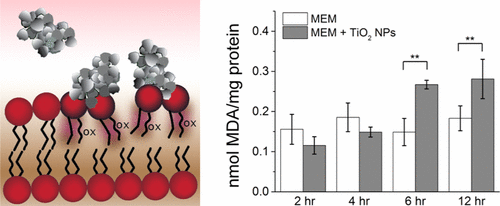当前位置:
X-MOL 学术
›
J. Phys. Chem. B
›
论文详情
Our official English website, www.x-mol.net, welcomes your
feedback! (Note: you will need to create a separate account there.)
TiO2 Nanoparticle-Induced Oxidation of the Plasma Membrane: Importance of the Protein Corona
The Journal of Physical Chemistry B ( IF 2.8 ) Pub Date : 2017-09-11 00:00:00 , DOI: 10.1021/acs.jpcb.7b04208 Sabiha Runa , Melike Lakadamyali 1 , Melissa L. Kemp 2 , Christine K. Payne
The Journal of Physical Chemistry B ( IF 2.8 ) Pub Date : 2017-09-11 00:00:00 , DOI: 10.1021/acs.jpcb.7b04208 Sabiha Runa , Melike Lakadamyali 1 , Melissa L. Kemp 2 , Christine K. Payne
Affiliation

|
Titanium dioxide (TiO2) nanoparticles, used as pigments and photocatalysts, are widely present in modern society. Inhalation or ingestion of these nanoparticles can lead to cellular-level interactions. We examined the very first step in this cellular interaction, the effect of TiO2 nanoparticles on the lipids of the plasma membrane. Within 12 h of TiO2 nanoparticle exposure, the lipids of the plasma membrane were oxidized, determined with a malondialdehyde assay. Lipid peroxidation was inhibited by surface passivation of the TiO2 nanoparticles, incubation with an antioxidant (Trolox), and the presence of serum proteins in solution. Subsequent experiments determined that serum proteins adsorbed on the surface of the TiO2 nanoparticles, forming a protein corona, inhibit lipid peroxidation. Super-resolution fluorescence microscopy showed that these serum proteins were clustered on the nanoparticle surface. These protein clusters slow lipid peroxidation, but by 24 h, the level of lipid peroxidation is similar, independent of the protein corona or free serum proteins. Additionally, over 24 h, this corona of proteins was displaced from the nanoparticle surface by free proteins in solution. Overall, these experiments provide the first mechanistic investigation of plasma membrane oxidation by TiO2 nanoparticles, in the absence of UV light and as a function of the protein corona, approximating a physiological environment.
中文翻译:

TiO 2纳米粒子诱导的质膜氧化:蛋白电晕的重要性。
用作颜料和光催化剂的二氧化钛(TiO 2)纳米颗粒在现代社会中广泛存在。吸入或摄入这些纳米颗粒会导致细胞水平的相互作用。我们检查了这种细胞相互作用的第一步,即TiO 2纳米颗粒对质膜脂质的影响。在TiO 2纳米颗粒暴露的12小时内,质膜的脂质被氧化,用丙二醛测定法确定。TiO 2纳米颗粒的表面钝化,与抗氧化剂(Trolox)的孵育以及溶液中血清蛋白的存在抑制了脂质的过氧化。随后的实验确定血清蛋白吸附在TiO 2的表面上纳米粒子形成蛋白质电晕,抑制脂质过氧化。超分辨率荧光显微镜显示,这些血清蛋白聚集在纳米颗粒表面。这些蛋白质簇减缓脂质过氧化作用,但是到24小时,脂质过氧化作用的水平是相似的,独立于蛋白质电晕或游离血清蛋白质。另外,在24小时内,蛋白质的这种电晕被溶液中的游离蛋白质从纳米颗粒表面置换。总体而言,这些实验提供了在不存在紫外线的情况下,TiO 2纳米颗粒对质膜氧化的首次机理研究,并且是蛋白质电晕的函数,近似于生理环境。
更新日期:2017-09-11
中文翻译:

TiO 2纳米粒子诱导的质膜氧化:蛋白电晕的重要性。
用作颜料和光催化剂的二氧化钛(TiO 2)纳米颗粒在现代社会中广泛存在。吸入或摄入这些纳米颗粒会导致细胞水平的相互作用。我们检查了这种细胞相互作用的第一步,即TiO 2纳米颗粒对质膜脂质的影响。在TiO 2纳米颗粒暴露的12小时内,质膜的脂质被氧化,用丙二醛测定法确定。TiO 2纳米颗粒的表面钝化,与抗氧化剂(Trolox)的孵育以及溶液中血清蛋白的存在抑制了脂质的过氧化。随后的实验确定血清蛋白吸附在TiO 2的表面上纳米粒子形成蛋白质电晕,抑制脂质过氧化。超分辨率荧光显微镜显示,这些血清蛋白聚集在纳米颗粒表面。这些蛋白质簇减缓脂质过氧化作用,但是到24小时,脂质过氧化作用的水平是相似的,独立于蛋白质电晕或游离血清蛋白质。另外,在24小时内,蛋白质的这种电晕被溶液中的游离蛋白质从纳米颗粒表面置换。总体而言,这些实验提供了在不存在紫外线的情况下,TiO 2纳米颗粒对质膜氧化的首次机理研究,并且是蛋白质电晕的函数,近似于生理环境。











































 京公网安备 11010802027423号
京公网安备 11010802027423号